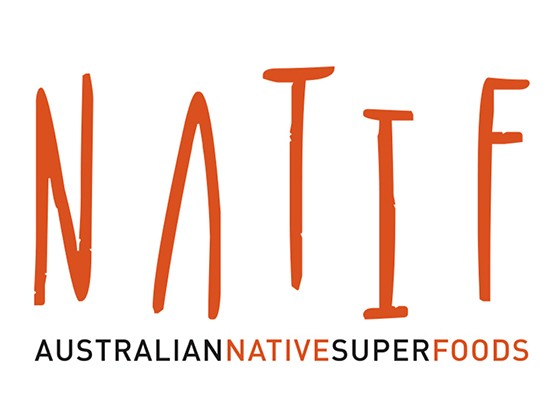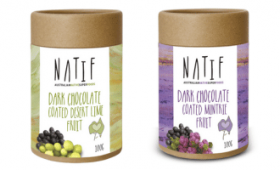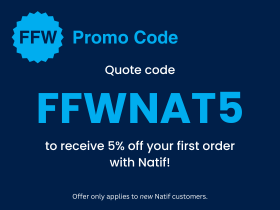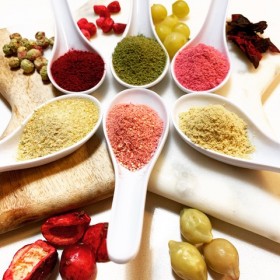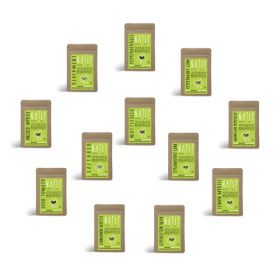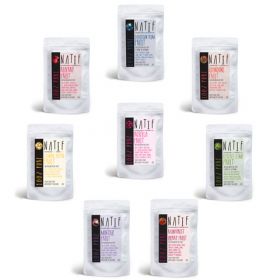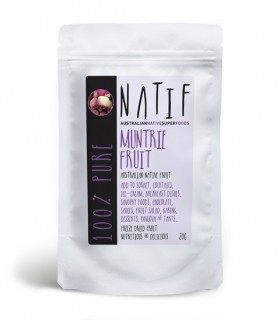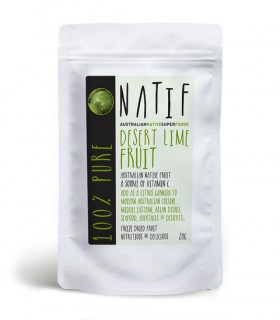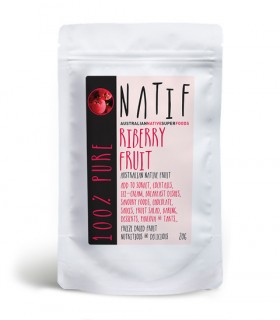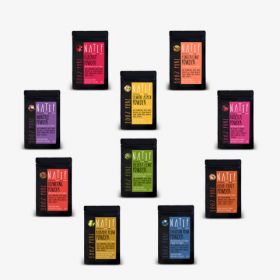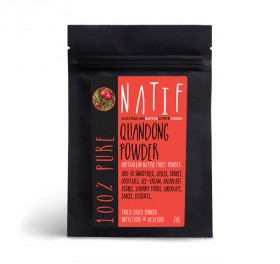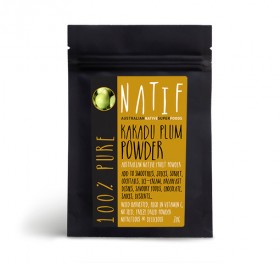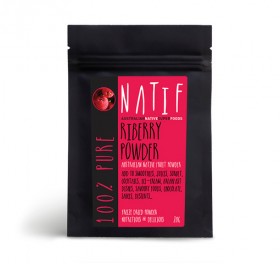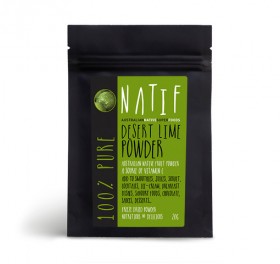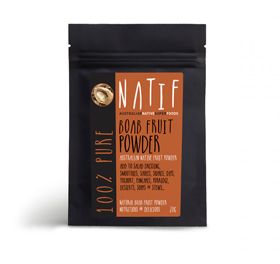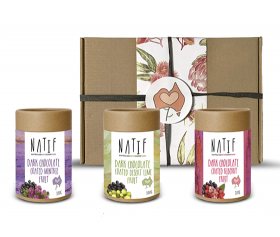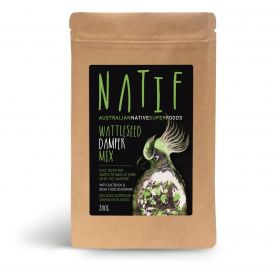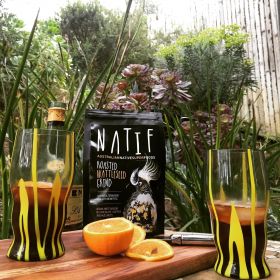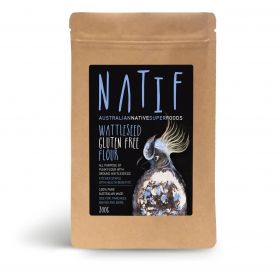Interview - Julie Merlet - NATIF Australian Native Superfoods
If you could go out into the bush and gather some of the world’s most ancient, most nutritionally dense and undeniably tasty foods, would you? Great news! You don’t have to because Julie Merlet, Director of NATIF Australian Native Superfoods has it all covered. She works with Indigenous communities who wild-harvest these precious gifts and turns them into easy-to-use products that bring the outback to city tables.
FFW: Who is behind the NATIF company?
NATIF AUSTRALIAN NATIVE SUPERFOODS: Julie Merlet – Nutritionist and Wellness Consultant, Australian Native Foods Promoter and lover of Australian native fauna and flora, big natural landscapes and interesting people.
FFW: Can you tell us about your nutritionist qualifications and how they come into play with NATIF?
NATIF AUSTRALIAN NATIVE SUPERFOODS: About 17 years ago I studied four years of Health Science (Naturopathy) at the Melbourne College of Natural Medicine (now Endeavour College). This inspired our family to move to the northeast in country Victoria on 25 acres to live the naturopathic lifestyle where we grew culinary and native herbs and plants, fruit trees and organic vegetables for our own usage. The idea of growing crops of Australian native foods there seemed ideal to me. I was always reading books, looking up information and researching about Australian native foods way back then. When we moved back to Melbourne I continued to study and update my knowledge in nutrition by doing a year’s study for a Certificate in Human Nutrition and then continued on-campus study at the AIAS (Australian Institute of Applied Science) full time for the Advanced Diploma in Nutritional Medicine. Native food was always in the background of my mind. As soon as I finished my studies, every cell in my body was telling me to do something with Australian native foods, that’s when NATIF came to life.
FFW: Is it true that some of the products you offer are foods that were used as traditional medicine for Indigenous people?
NATIF AUSTRALIAN NATIVE SUPERFOODS: Absolutely. But that is a story for Indigenous/First People to tell. This information belongs to Indigenous people. They lived here for thousands of years and they had their own medicine knowledge passed down through generations. We need to respect and also be patient and careful about how we use these foods for medicine as there needs to be more research into this field before they are put onto the ‘Nutriceuticals’. Australian native foods, the ones used in NATIF products have been researched by Australian Government bodies and are safe to use as part of a healthy balanced diet.
It’s like Ayurvedic or Chinese Medicine – its unfamiliar to some people. But I think there is potential for a market for Australian Indigenous traditional medicine, run by Australian Indigenous people.
‘Food as Medicine’ is an old concept and is a growing Industry now. When I saw the nutritional potential of NATIF foods I was drawn to them and wanted to include them into my diet, especially because they are Australian native foods which are meant for all Australians and links us to our environment.
FFW: What inspired you to start a business offering bush tucker ingredients?
NATIF AUSTRALIAN NATIVE SUPERFOODS: Definitely travelling in remote areas of Australia and noticing the lack of fresh healthy produce at road houses and small towns. All but one had some education about how to eat healthier and offered fruit at the register instead of sweets and fried fatty foods. It is so difficult to get food transportation into these remote areas. We take it for granted living in the bigger cities.
When we introduced the western diet to Indigenous people we also took away their desire to go out and eat the foods they used to eat, which were quite nutritious. They still eat native foods to some degree and there is a lot going on (if you watch NITV) with education and rehabilitation of traditional knowledge and usage of native foods. I think Indigenous people are very aware of the risk of losing these foods to other agricultural farming and so they are doing their best to teach younger Indigenous children about them so it stays strong in their culture. Their connection to native foods is part of their world.
In a way, I felt responsible for what we had done that to them. I wanted to formally apologise to them personally (even though it was not my fault directly). I have done that in my own way and asked permission to do what I do with NATIF. This is the morals and ethics behind the NAITF brand.
I really wanted to go back and help them with how to be healthy with all types of foods groups we had access to in the city as well as the importance of native foods too. They have so many health issues related to diet and I thought we could share the modern health revolution ideas with them and we could also use more of the traditional foods they eat. This sharing of foods I though could bring us more together. Natif was born from this concept too. I wanted to reach out to them and share my appreciation for what I had learnt about their culture and let them know that there are many people in the cities who appreciate it too. They are so isolated at times and opening up and connecting with them in small ways was important to me and I felt strong about what I needed to do. It’s important not to impose yourself onto these communities; we must respect that. Everything I have done in my life from study to having a strong connection to nature has led me to here.
Through NATIF there are opportunities for me to give back and help provide demand for this type of product, slowly but surely. This in turn creates an awareness and an opportunity for some communities to gain employment, work on the land they love and they can grow an industry for themselves. We can source native foods from Traditional Homeland Enterprises and from Australian Native Food Farmers. I want to support this through my business, share knowledge and walk together. It’s such a bigger picture than making money. Every day I wake, as hard as the native food industry can be, I still love what I do and I am thankful.
We have destroyed so much of our native assets through agriculture, mining, introduction of foreign species and modern developments and so much of the food that used to grow naturally here in Australia is lost. There are thousands of native foods that we could eat. Maybe the growth of this industry can give us the last chance to reclaim what nature has given us on home soil. We have a food bowl that needs to be tapped into and which gives us an identity from the rest of the world; even though we are multicultural this still remains the true native food of Australia.
FFW: Are all the products certified organic?
NATIF AUSTRALIAN NATIVE SUPERFOODS: Some are, like the Lemon and Aniseed Myrtle and others, but some Australian Native Food farmers have been doing it tough and holding out for many years now and they can’t afford certification, it just costs too much for them, even though they still grow it organically. Even better than organic is the wild harvested produce like Kakadu Plum, Bush Tomatoes and Wattleseed. These plants have adapted over millions of years to the harsh environment and so the nutrients are quite condensed in these. Sometimes if you lay a bed and make it easier the plant can slacken off! Science is catching up to this though and some of the projects going on are very interesting in the way that they will be able to still be nutritious, even with plantations. Only time will tell. This is where Indigenous knowledge can beat science as they have the skills and know how through practice. Top secret information for now! Haha. There is much trust to build. We are also in danger of losing native species to be grown overseas. This is already happening and people are trying to patent native ingredients and use words which belong to Indigenous people. Some of these foods are wild harvested on Native Land Titles and the intellectual knowledge also belongs to them too. If you do business in native foods, then you need to go slow; ‘Stop, Look and Listen’ so you don’t offend anyone.
FFW: Where do your native fruits and spices come from? Are they grown commercially? Who harvests or locates them for you?
NATIF AUSTRALIAN NATIVE SUPERFOODS: The Native fruits, herbs and spices come from all around Australia. I always source from Indigenous Wild Harvesters and Australian Native Food Farmers. The foods that are wild harvested can be difficult to get to in location, or they can be all of a sudden wiped out by floods, ants or other natural events. When you take wild foods and start to make plantations, that can all go wrong as well. Indigenous people know so much about the best plants, the methods of growing these foods and which ones to harvest and where they will or won’t grow. Other Native food farmers are good at it too.
For the Kakadu Plum we are talking about remote communities and locations, with long grass, 4x4 and walking for days. Mostly women with children will go and gather the fruits. They need to be bought back quickly to be refrigerated. The logistics of having Kakadu Plum in Melbourne as a powder is quite a task and this is reflected in the current prices. NATIF Kakadu Plum contains no seed so this has to be taken out as well.
Native food farmers from around Australia are mainly small farmers who have always had a love for these foods. They have been in this industry for many years. Some of the farmers have been making products from native foods for over 20 years and more. I remember seeing them and buying them from farmers’ markets on my travels around Australia when I was a younger. It’s only now becoming ‘fashionable’ and we are seeing the market pick up. People are making ice creams, icy poles, bottled juices and lots of other products out of these foods. The market is open to anyone wanting to make products out of these ‘new’ foods. The more we make, the more demand for the products and in turn this will be great for all the wild harvesters and farmers around Australia. I think it’s great for us to get behind them all.
Some farmers are horticulturists (even saving species from extinction); some have stayed with the business through the difficult times and are still struggling. Some plantations are doing really well and selling off shore to other countries.
It’s really such a mix of interesting people. What I absolutely love about my job is that I get to speak to the people on the land, I listen to them and understand, having been a farmer myself.
FFW: Do you think the use of bush tucker ingredients in restaurants has matured? Is there still a novelty factor or do you think they’re now used for their sophistication and unique flavour profiles?
NATIF AUSTRALIAN NATIVE SUPERFOODS: Absolutely, but not enough and still a long way to go. I think there is still a novelty factor and this can change with education. This is why I did farmers’ markets for so long. I really wanted to educate people on how to use them and tell about the nutritional benefits and that they were safe to use as part of a healthy, balanced diet.
They do have a sophistication about them because they’re intriguing and new with unique flavours and aromas. Especially when someone like Rene Redzepi from Noma restaurant comes to Sydney and creates a unique culinary experience and showcases this food as a work of art. There are many other chefs around the country like Clayton Donovan, Mark Olive, Andrew Fielke, Paul Cooper, Kylie Wong, Jock Zonfrillo, and many others who are working with native foods at cafés and restaurants. But I would like to see them more in people’s homes and just using them as part of their normal diet. There is so much conversation to be had around these foods. Everything from Indigenous issues to politics and science. I can’t get enough of the bigger picture myself and that’s why I love them.
The flavour profiles can be a challenge as they have not always had the best reputation for taste. This can be overcome by cooking methods and techniques. They have a taste of their own, unique, interesting and surprising. Any good chef can create a fabulous dish with these foods. You just need to experiment and be adventurous and you will be rewarded. The home cook can do it too; once you are familiar with something it just becomes a normality.
FFW: Are you finding that home cooks enjoy using bush tucker ingredients too? Or do they need more education/inspiration/information?
NATIF AUSTRALIAN NATIVE SUPERFOODS: Home cooks are enjoying them. At farmers’ markets I had people who were purchasing from me and making homemade gourmet chocolates. Others were baking with them, making soups and other common dishes. Once I told them how to use them and to refer to some recipes on my blog at NATIF they had a reference to go to. It was challenging I must say, getting people to use and cook with them. Well worth it though.
The people who did ‘Stop, Look and Listen’ were so intrigued and just wanted to know more and couldn’t believe that we had ignored these foods for so long. After 250 years they are just starting to be more commonplace and used more in Australian homes.
At NATIF we have many other ideas to come for the business. Watch this space! I am determined to get everyone interested in cooking with these foods and feeling comfortable with them as much as I can. This can generate an industry for Indigenous communities and other farmers who want to stay on the land and harvest these types of foods, which creates employment, enjoyment and a sense of wellbeing.
FFW: If a home cook wanted to start using these ingredients, what would you suggest are the three must-haves for the pantry as somewhat of a ‘starter kit’?
NATIF AUSTRALIAN NATIVE SUPERFOODS: Must haves are:
- NATIF Bush Tomatoes (for pasta sauces and sliced or grated very thinly like truffles onto salads for a pop of flavour).
- NATIF Salt Bush and NATIF Pepper Leaf (you can use these like an alternative to salt and pepper); healthy too.
- NATIF Kakadu Plum (as ½ a teaspoon gives you 4xRDI for Vitamin C along with other nutrients for good health it can be used on top of any cold dessert, into smoothies and juices, sprinkled onto breakfast cereals, salads, avocado smash and anything else you can create.
- NATIF Quandong (soak them to add to desserts, baking, tarts and even adding them dried to soups and slow cooking dishes). Easy for a burst of flavour that’s unique and different.
- NATIF Wattle Seed
- NATIF Pepper Berries
FFW: Which of your products was a revelation to you, either in flavour, usage, how it’s grown or some other fascinating insight?
NATIF AUSTRALIAN NATIVE SUPERFOODS: The Kakadu Plum because its grown in one of my favourite parts of Australia, the Kimberley and Northern Territory. Discovering its nutritional values mostly and how it was used other than food consumption, as a preservative in the seafood industry and in cosmetics globally.
I loved the flavour as it doesn’t overpower anything you add it to. Its gentle subtle taste and smell of stewed apples and pears made it easy to accept. I have eaten them as a fruit and they are quite nice as they are. NATIF Kakadu Plum powder lasts for over a year in a cool dry place so it’s easy to store at home.
I love everything about Kakadu Plum, where it’s grown, the traditional land it’s grown on, the interesting people who wild harvest it, the traditional use, the story that’s still developing and what it means for the future for Indigenous people. The Kindred Spirits Foundation is working hard with traditional land holders to make sure that these native foods stay owned by Indigenous communities for the future.
FFW: Do you ever ‘prescribe’ any of your products for wellness purposes?
NATIF AUSTRALIAN NATIVE SUPERFOODS: I prefer to educate people on the nutritional benefits and how to use these foods as part of a healthy balanced diet. I believe in ‘Food as Medicine’ and if these foods have high nutritional status then I would highly recommend them as part of a person’s diet. I think if you can get your nutrients from a balanced diet using whole-foods, organic where you can and un-processed, and practice a wellness type of lifestyle then your health will benefit and you can even prevent diseases. If you’re lacking in certain nutrients, then certain NATIF foods could help restore vitamin deficiencies. I would prescribe them as you would any other food that is beneficial. Every person has a unique health story so you need to be careful generalising a person’s health and making statements that are mainstream. I like to take a full case history and that can take 90 minutes before I give specific nutritional advice.
I have Kakadu Plum in various dishes at least three times a week because of the high vitamin C and other nutrients for good health. I feel energised, alert and I am sure my immune system has loved it as I haven’t been sick all year.
Desert Lime and Davidson Plum have good levels of nutrients as well and that’s why the three are my choice in ‘Superfoods’ that have good research behind them. (Superfoods is really just another name for ‘nutrient dense’). I avoid food fads too as it takes the enjoyment out of eating.
Wattleseed contains good amounts of low glycaemic carbohydrates, protein, calcium, zinc, magnesium and others nutrients for good health as well. It is closely related to a legume rather than a seed.
Health benefits can be found on the blog on my website in June 2016 called ‘Health Benefits of Australian Native Foods’, in which I summarised a 40-page document (RIRDC) for people to read on the ‘Health Benefits of Australian Native Foods’. This document is key to native foods nutritional education and most of the people in the industry all get their information from this. There are lots of other key information documents too. Have a look and discover more basic information from the NATIF website.
FFW: Where would you like to see NATIF products offered for sale?
NATIF AUSTRALIAN NATIVE SUPERFOODS: Everywhere!! Retail stores, health food stores, green grocery stores, fine food stores, farmers’ markets, country food trails, restaurants, cafes, juice bars, Qantas Airways and airports, school canteens, overseas. Just like any other food. It’s our native food – it’s meant for all Australians; I think it should be everywhere and easier to access – one day, if I can help it, that’s my mission!!
I would like to see Native foods being taught at schools and on tours for tourists. We can feel proud about this food, it’s what connects us with our environment. If we look after our environment like Indigenous people did for thousands of years then these foods can grow in abundance for all of us. That’s why it’s so important to create a demand for native foods because of the bigger picture for all Australians, native fauna and flora. It’s what connects us to our home land.
FFW: What do you feel are the most compelling features of your brand?
NATIF AUSTRALIAN NATIVE SUPERFOODS: It’s pure, organic, wild harvested, ethical, Australian made and owned and most of all that the NATIF brand is part of a bigger picture with passion for the environment, love for nature and how we connect with it, the Australian Native Food Industry, Indigenous people and all Australians. I think through native foods it’s our chance to save native species including bees too because without them we have no food. We are part of the food chain and NATIF foods are key to this concept for the brand.
FFW: Do NATIF products help chefs, cooks and food manufacturers innovate?
NATIF AUSTRALIAN NATIVE SUPERFOODS: Yes, providing NATIF (native) food helps chefs create new foods and dishes that are exciting and innovative. They can create new menus and specials that will intrigue customers. I want to help chefs and cooks who don’t know much about them and tell them how they can use them with the ones I know. I welcome anyone who wants to know more; I love it.
When I go into a café and speak with chefs, most are excited and interested to have access to these foods. I have food developers buying NATIF so they can create new products. I feel so excited for them as they embark on an adventure with these foods, just like I did when I started a long time ago.
FFW: Where would you love to see NATIF products offered or featured?
NATIF AUSTRALIAN NATIVE SUPERFOODS: Retail stores, health food stores, green grocery stores, fine food stores, farmers’ markets, country food trails, restaurants, cafes, juice bars, Qantas Airways and airports, school canteens and home economic classes, overseas in restaurants, MasterChef and all other cooking shows.
MasterChef – In fact Gary from MasterChef came to my market stall as part of the Melbourne Food and Wine Festival just next to his restaurant ‘The Boat House’ along the Maribyrnong River in Melbourne and I spoke to him about native foods and gave him lots of NATIF food to use. I am not sure if it was the food I gave him but the foods did appear a few times on MasterChef 2016. Native Quandongs were part of a challenge test as being one of the most difficult foods but when I saw them I thought it was easy! Bush Tomatoes were used as a flavour enhancer to give a rich tomato based sauce and native finger limes were used as well as Lemon Myrtle. I would love more cooking shows to showcase our native foods.
FFW: How do you help your clients to promote NATIF products?
NATIF AUSTRALIAN NATIVE SUPERFOODS: I offer a new modern small carousel which hangs up to 20 products. The idea behind it was that if you wanted to cook Australian native food you could go straight up to it and get all the native ingredients you needed to create your dish.
I also help to find shelving solutions for each store depending on how they would like to showcase them. I give free samples to chefs and cooks in cafes and juice bars too so they can design new drinks around them.
I have information brochures which give hints on how to use each one on one sheet so that anyone who wants to buy part of the NATIF family of foods will have some idea of where to start – then I refer them to my ever evolving BLOG on the NATIF website to see more. I am no chef but I do try!! This brochure can sit on top of the stand too, in a perplex holder, which rotates with the carousel. Otherwise they can be displayed next to the NATIF products. People can call me by phone or email with any queries they have. I am putting together a recipe book next year with a video on my website similar to a YouTube cooking show – when I get some time!
I truly believe that if we get behind the Australian Native Food Industry that this will have many benefits for all Australians.
There’s no denying the passion that Julie has for native foods! With such a fabulous range of conscientious products on offer, there’s never been a better time to dip your toe in the billabong and try a recipe featuring Indigenous wild-harvested ingredients. For more information or to place your first order, contact Natif today.
